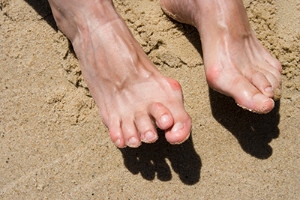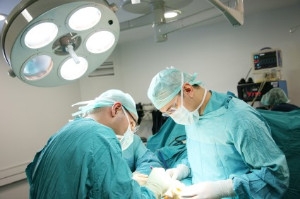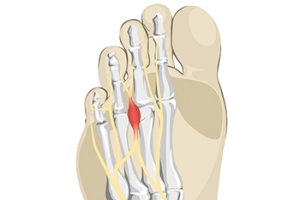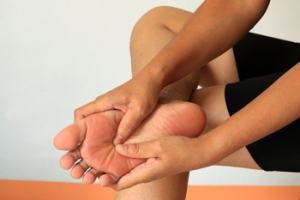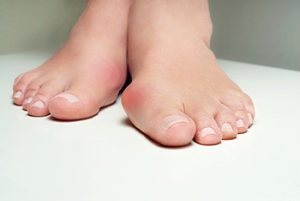Connect With Us

What Is a Hammertoe?
 The uncomfortable foot condition that is known as a hammertoe is considered to be a foot deformity. It can occur from genetic factors, or from wearing shoes that do not have adequate room for the toes to move freely in. The joints in the middle toes are typically affected, and can bend downward, which may resemble a hammer. Some patients have calluses that develop on top of the toes, and this may be a result of the toes rubbing against the top of the shoe. It may be beneficial to cease wearing pointed shoes such as high heels. Additionally, mild relief may be found when a protective pad is worn on the impacted toe. Severe hammertoes may cause pain and discomfort, and surgery may be a viable option to permanently straighten the toes. If you are afflicted with a hammertoe, it is suggested that you consult with a podiatrist as quickly as possible who can guide you toward the treatment that is best for you.
The uncomfortable foot condition that is known as a hammertoe is considered to be a foot deformity. It can occur from genetic factors, or from wearing shoes that do not have adequate room for the toes to move freely in. The joints in the middle toes are typically affected, and can bend downward, which may resemble a hammer. Some patients have calluses that develop on top of the toes, and this may be a result of the toes rubbing against the top of the shoe. It may be beneficial to cease wearing pointed shoes such as high heels. Additionally, mild relief may be found when a protective pad is worn on the impacted toe. Severe hammertoes may cause pain and discomfort, and surgery may be a viable option to permanently straighten the toes. If you are afflicted with a hammertoe, it is suggested that you consult with a podiatrist as quickly as possible who can guide you toward the treatment that is best for you.
Hammertoes can be a painful condition to live with. For more information, contact Dr. Michael D. Garvin of Florida. Our doctor will answer any of your foot- and ankle-related questions.
Hammertoe
Hammertoe is a foot deformity that occurs due to an imbalance in the muscles, tendons, or ligaments that normally hold the toe straight. It can be caused by the type of shoes you wear, your foot structure, trauma, and certain disease processes.
Symptoms
- Painful and/or difficult toe movement
- Swelling
- Joint stiffness
- Calluses/Corns
- Physical deformity
Risk Factors
- Age – The risk of hammertoe increases with age
- Sex – Women are more likely to have hammertoe compared to men
- Toe Length – You are more likely to develop hammertoe if your second toe is longer than your big toe
- Certain Diseases – Arthritis and diabetes may make you more likely to develop hammertoe
Treatment
If you have hammertoe, you should change into a more comfortable shoe that provides enough room for your toes. Exercises such as picking up marbles may strengthen and stretch your toe muscles. Nevertheless, it is important to seek assistance from a podiatrist in order to determine the severity of your hammertoe and see which treatment option will work best for you.
If you have any questions, please feel free to contact our offices located in Port St. Lucie, FL . We offer the newest diagnostic and treatment technologies for all your foot care needs.
Hammertoe
Hammertoe is a foot deformity that occurs due to an imbalance in the tendons, muscles, or ligaments that are responsible for holding the toes in their normal position. This condition may be caused by poor footwear, foot structure, trauma, and disease. The most common solution for hammertoe is to relieve the pain by changing your footwear and wearing orthotics. In severe cases, surgery may be required.
The shoes that are most likely to cause hammertoe are high heeled shoes or shoes that are too tight in the toe box. Tight shoes will force your toes to crowd together in a curled position. This position will likely continue when you take your shoes off. Another cause is trauma. When you stub your toe, you are increasing the chance that you will develop hammertoe.
There are risk factors that may make you more likely to develop this condition. Women are more likely to have the condition compared to men, and it is also more likely to appear in those who are older in age.
Many different foot problems can be avoided by wearing shoes that have adjustability, adequate toe room, and low heels. Furthermore, if you want to buy new shoes, you should look to purchase them at the end of the day and make sure you know your correct size. The importance of buying shoes at the end of the day is that your feet swell as the day progresses. You should also ensure that you are wearing your correct size because your shoe size may change as you grow older.
To diagnose someone with hammertoe, your podiatrist will need to conduct a thorough examination of your foot. Your doctor may even order an x-ray to evaluate the bones and joints of your feet and toes.
If you have hammertoe, your podiatrist may recommend that you wear shoes that fit you better along with inserts to place inside them. Additionally, he or she may suggest special exercises for you to perform to stretch your toes. One helpful exercise it to pick up marbles with your feet or crumple a towel with your toes.
Prior to meeting with your podiatrist, it will be helpful to make a list of all the symptoms you are experiencing. You should also make a note of medications you are taking and important personal information about your medical history.
Joint Replacement for Arthritis of the Big Toe
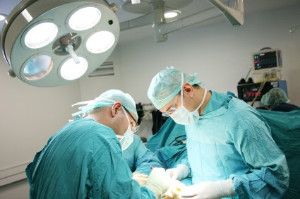
The base of the big toe is a common site for degenerative changes in the foot. Wear and tear and loss of elasticity in the cartilage cushioning the joint of the big toe can cause pain, swelling, and stiffness in the area. With the big toe moving up each time a step is taken, walking can be uncomfortable. Bone spurs can develop on the joint aggravating the pain already felt when walking with big toe arthritis. A bump, like a bunion or a callus, can also develop on the top of the foot with this affliction. When rest, medication, and exercise stop working, surgical options are considered. One such option is toe joint replacement. This is usually done among older sufferers with advanced arthritis. With toe joint replacement, an artificial joint made from ceramic, plastic, or metal, is surgically implanted after removing damaged parts of bones and cartilage in the big toe. This can be done under general or regional anesthesia and usually takes less than one hour. If you have advanced arthritis in your big toe and other less invasive treatments have not provided you enough relief to live life comfortably, talk to a podiatrist to see if you might be a good candidate for joint replacement surgery.
In certain cases, in which the patient suffers from extreme pain or damage in a joint, joint replacement surgery may be deemed useful. If you have constant pain in a foot joint, consult with Dr. Michael D. Garvin from Florida. Our doctor will assess your condition and provide you with quality foot and ankle treatment.
What Is Joint Replacement Surgery?
Over time, joints wear down; this can be exacerbated by diseases and conditions. Joint replacement surgery, also known as arthroplasty, is when a damaged joint is surgically removed and replaced with a prosthesis. Prostheses, which can be made of ceramic, plastic, or metal, act as joints in lieu of an actual joint. One of the most prevalent causes for joint replacement is arthritis.
Arthritis in the Foot
Arthritis can occur in any joint in the body, including in the feet. Common types of arthritis in the foot are osteoarthritis, rheumatoid arthritis, and gout. The big toe is usually where arthritis occurs in the foot; this is known as hallux rigidus.
Joint Replacement Surgery in the Foot
The most common form of joint replacement in the foot is a first metatarsophalangeal (MTP) joint placement. MTP joint replacement surgery is designed to treat hallux rigidus. Surgery is not intensive, and recovery occurs within one to two months after the procedure has been done. Overall, joint replacement surgery is a safe and effective way to treat pain in the joint of the foot.
If you have any questions, please feel free to contact our offices located in Port St. Lucie, FL . We offer the newest diagnostic and treatment technologies for all your foot care needs.
Joint Replacement Surgery
When conservative, noninvasive treatments prove unsuccessful, podiatrists will often turn to surgery as the last line of treatment for their patients. If patients are suffering from joint pain, issues in mobility, or are seeking to correct a deformity, joint replacement surgery is an effective option. Joint replacement surgery is also successful in treating arthritis, which is the most common cause of improperly working joints.
Patients with symptoms that include joint pain, stiffness, limping, muscle weakness, limited motion, and swelling are typically considered for joint replacement surgery. Range of motion and activity post-surgery will vary between patients and depending on the specific surgery performed, the affected joint, and the damage that will need to be repaired.
Joint replacement surgery replaces the damaged cartilage and bone, the latter if required. The damaged cartilage is typically replaced with a prosthesis that is attached to the bone, allowing the implant to grow into the bone. Following surgery, the patient will typically undergo physical therapy to become familiar with movement using the replaced joint.
High Heels and Morton’s Neuroma
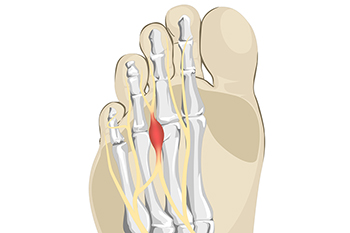
Morton’s neuroma is a foot condition that can develop in women who frequently wear high heels. This condition can result from having inadequate room for the toes to move freely in and can cause the nerve between the third and fourth toes to become compressed. Irritation and inflammation may accompany this, which can cause severe pain and discomfort. Patients who have Morton’s neuroma often say the sensation they feel is similar to having a pebble or marble in the shoe, in addition to numbness and tingling. Mild relief may also be found when soft insoles are worn, the feet are elevated, and shoes that are worn have a wide toe area. Existing medical conditions may contribute to Morton’s neuroma. These can include flat feet, bunions, and hammertoes. If you feel you may have this foot condition, it is advised that you speak to a podiatrist who can properly treat this ailment.
Morton’s neuroma is a very uncomfortable condition to live with. If you think you have Morton’s neuroma, contact Dr. Michael D. Garvin of Florida. Our doctor will attend to all of your foot care needs and answer any of your related questions.
Morton’s Neuroma
Morton's neuroma is a painful foot condition that commonly affects the areas between the second and third or third and fourth toe, although other areas of the foot are also susceptible. Morton’s neuroma is caused by an inflamed nerve in the foot that is being squeezed and aggravated by surrounding bones.
What Increases the Chances of Having Morton’s Neuroma?
- Ill-fitting high heels or shoes that add pressure to the toe or foot
- Jogging, running or any sport that involves constant impact to the foot
- Flat feet, bunions, and any other foot deformities
Morton’s neuroma is a very treatable condition. Orthotics and shoe inserts can often be used to alleviate the pain on the forefront of the feet. In more severe cases, corticosteroids can also be prescribed. In order to figure out the best treatment for your neuroma, it’s recommended to seek the care of a podiatrist who can diagnose your condition and provide different treatment options.
If you have any questions, please feel free to contact our offices located in Port St. Lucie, FL . We offer the newest diagnostic and treatment technologies for all your foot care needs.
What is Morton's Neuroma?
Morton’s neuroma, (also referred to as Morton’s metatarsalgia, Morton’s neuralgia, plantar neuroma or intermetatarsal neuroma) is a condition that is caused when the tissue around one of the nerves between your toes begins to thicken. This thickening can result in pain in the ball of the foot. Fortunately, the condition itself is not cancerous.
Morton’s neuroma affects women more often than men with a ratio of 4:1. It tends to target women between the age of 50 and 60, but it can occur in people of all ages. There are some risk factors that may put you at a slightly higher risk of developing the condition. People who often wear narrow or high-heeled shoes are often found to be linked to Morton’s neuroma. Additionally, activities such as running or jogging can put an enormous amount of pressure on the ligament and cause the nerve to thicken.
There usually aren’t any outward symptoms of this condition. A person who has Morton’s neuroma may feel as if they are standing on a pebble in their shoe. They may also feel a tingling or numbness in the toes as well as a burning pain in the ball of their foot that may radiate to their toes.
In order to properly diagnose you, the doctor will press on your foot to feel for a mass or tender spot. He may also do a series of tests such as x-rays, an ultrasound, or an MRI. X-rays are usually done to rule out any other causes for your foot pain such as a stress fracture. Ultrasounds are used to reveal soft tissue abnormalities that may exist, such as neuromas. Your podiatrist may want to use an MRI in order to visualize your soft tissues.
There are three main options for treatment of Morton’s neuroma: Injections, decompression surgery, and removal of the nerve. Injections of steroids into the painful area have been proven to help those with Morton’s neuroma. Decompression surgery has been shown to relieve pressure on the affected nerve by cutting nearby structures such as the ligaments in the foot. Another treatment option would be to surgically remove the growth to provide pain relief.
If you suspect that you have Morton’s neuroma you should make an appointment with your podiatrist right away. You shouldn’t ignore any foot pain that lasts longer than a few days, especially if the pain does not improve.
The Progression of PAD
 Peripheral artery disease (PAD) is a condition that causes reduced blood flow in the lower limbs. PAD is fairly common, particularly in older people, and is caused by a buildup of plaque along the walls of the arteries. The plaque makes the arteries narrow and harden, which makes it harder for blood to circulate to the lower limbs and provide the muscles with oxygen and nutrients. This leads to symptoms that include pain, achiness, fatigue, burning, muscle cramps, and overall discomfort in the feet and ankles. At first, these symptoms may just appear when you do more strenuous physical activities like walking uphill, walking for longer distances, or running. Eventually, however, the symptoms may worsen and appear after only a little bit of activity. You may also begin to experience numbness in your lower limbs when you are at rest. If you have symptoms of PAD, please seek the care of a podiatrist.
Peripheral artery disease (PAD) is a condition that causes reduced blood flow in the lower limbs. PAD is fairly common, particularly in older people, and is caused by a buildup of plaque along the walls of the arteries. The plaque makes the arteries narrow and harden, which makes it harder for blood to circulate to the lower limbs and provide the muscles with oxygen and nutrients. This leads to symptoms that include pain, achiness, fatigue, burning, muscle cramps, and overall discomfort in the feet and ankles. At first, these symptoms may just appear when you do more strenuous physical activities like walking uphill, walking for longer distances, or running. Eventually, however, the symptoms may worsen and appear after only a little bit of activity. You may also begin to experience numbness in your lower limbs when you are at rest. If you have symptoms of PAD, please seek the care of a podiatrist.
Peripheral artery disease can pose a serious risk to your health. It can increase the risk of stroke and heart attack. If you have symptoms of peripheral artery disease, consult with Dr. Michael D. Garvin from Florida. Our doctor will assess your condition and provide you with quality foot and ankle treatment.
Peripheral artery disease (PAD) is when arteries are constricted due to plaque (fatty deposits) build-up. This results in less blood flow to the legs and other extremities. The main cause of PAD is atherosclerosis, in which plaque builds up in the arteries.
Symptoms
Symptoms of PAD include:
- Claudication (leg pain from walking)
- Numbness in legs
- Decrease in growth of leg hair and toenails
- Paleness of the skin
- Erectile dysfunction
- Sores and wounds on legs and feet that won’t heal
- Coldness in one leg
It is important to note that a majority of individuals never show any symptoms of PAD.
Diagnosis
While PAD occurs in the legs and arteries, Podiatrists can diagnose PAD. Podiatrists utilize a test called an ankle-brachial index (ABI). An ABI test compares blood pressure in your arm to you ankle to see if any abnormality occurs. Ultrasound and imaging devices may also be used.
Treatment
Fortunately, lifestyle changes such as maintaining a healthy diet, exercising, managing cholesterol and blood sugar levels, and quitting smoking, can all treat PAD. Medications that prevent clots from occurring can be prescribed. Finally, in some cases, surgery may be recommended.
If you have any questions, please feel free to contact our offices located in Port St. Lucie, FL . We offer the newest diagnostic and treatment technologies for all your foot care needs.
Peripheral Artery Disease
Peripheral artery disease (PAD), or peripheral arterial disease, is a circulatory problem in which there is a reduction of blood flow to the limbs due to narrowed arteries. When peripheral artery disease develops, the extremities do not receive enough blood flow; this may cause symptoms to develop such as claudication, or leg pain when walking. The legs are the most common site of peripheral artery disease.
Claudication, or leg pain when walking, is one of several symptoms that can develop due to peripheral artery disease. Other symptoms caused by the disease include painful cramping in the hips, thighs, or calves after certain activities; leg numbness or weakness; coldness in the lower leg or foot; sores on the lower extremities that do not heal; hair loss on the lower extremities; and a missing or weak pulse in the lower extremities. In more severe cases, pain may even occur when the body is at rest or when lying down.
Peripheral artery disease is typically caused by atherosclerosis, a condition in which fatty deposits build up in the arterial walls and reduce blood flow. Smoking, diabetes, obesity, high blood pressure, and high cholesterol are some of the risk factors for peripheral artery disease.
If you are experiencing pain, numbness, or other symptoms in the lower extremities, see your healthcare professional immediately. Diagnosed peripheral artery disease can be treated with various medications, angioplasty and surgery, exercise programs, or alternative medicine. It is important to consult a healthcare professional to determine the best treatment for you.
Bunion Exercises
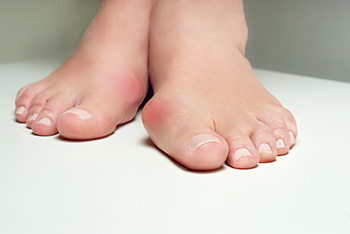 A bunion is described as a bony protrusion that forms on the side of the big toe. Many patients experience pain and discomfort from this ailment, and it may gradually worsen. It can happen as a result of genetic factors, or from wearing shoes that do not have adequate room for the toes to move freely in. The muscles can become weakened, and it is beneficial to perform specific foot stretches that may help to strengthen the affected area and overall foot. A foot scrunch helps to improve dexterity when performed regularly. This is done by placing a towel on the floor, and lifting it up with your foot. Toe yoga helps to improve mobility in the toes, which may positively affect general balance in the body. If you have developed a bunion, it is strongly suggested that you speak with a podiatrist who can offer you additional exercise and treatment options that are right for you.
A bunion is described as a bony protrusion that forms on the side of the big toe. Many patients experience pain and discomfort from this ailment, and it may gradually worsen. It can happen as a result of genetic factors, or from wearing shoes that do not have adequate room for the toes to move freely in. The muscles can become weakened, and it is beneficial to perform specific foot stretches that may help to strengthen the affected area and overall foot. A foot scrunch helps to improve dexterity when performed regularly. This is done by placing a towel on the floor, and lifting it up with your foot. Toe yoga helps to improve mobility in the toes, which may positively affect general balance in the body. If you have developed a bunion, it is strongly suggested that you speak with a podiatrist who can offer you additional exercise and treatment options that are right for you.
If you are suffering from bunion pain, contact Dr. Michael D. Garvin of Florida. Our doctor can provide the care you need to keep you pain-free and on your feet.
What Is a Bunion?
Bunions are painful bony bumps that usually develop on the inside of the foot at the joint of the big toe. As the deformity increases over time, it may become painful to walk and wear shoes. Women are more likely to exacerbate existing bunions since they often wear tight, narrow shoes that shift their toes together. Bunion pain can be relieved by wearing wider shoes with enough room for the toes.
Causes
- Genetics – some people inherit feet that are more prone to bunion development
- Inflammatory Conditions - rheumatoid arthritis and polio may cause bunion development
Symptoms
- Redness and inflammation
- Pain and tenderness
- Callus or corns on the bump
- Restricted motion in the big toe
In order to diagnose your bunion, your podiatrist may ask about your medical history, symptoms, and general health. Your doctor might also order an x-ray to take a closer look at your feet. Nonsurgical treatment options include orthotics, padding, icing, changes in footwear, and medication. If nonsurgical treatments don’t alleviate your bunion pain, surgery may be necessary.
If you have any questions, please feel free to contact our offices located in Port St. Lucie, FL . We offer the newest diagnostic and treatment technologies for all your foot care needs.
Bunions
A bunion is a bump that forms at the base of the big toe. Bunions form when the big toe pushes against the next toe, which forces the big toe joint to get bigger and stick out. As a result, the skin over the bunion may start to appear red and it may feel sore.
There are risk factors that can increase your chances of developing bunions. People who wear high heels or ill-fitting shoes are more likely to develop them, in addition to those who have a genetic history of bunions or have rheumatoid arthritis.
The most obvious way to tell if you have a bunion is to look for the big toe pushing up against the toe next to it. Bunions produce a large protrusion at the base of the big toe and may or may not cause pain. Other symptoms are redness, swelling, and restricted movement of the big toe if you have arthritis.
Nonsurgical methods are frequently used to treat bunions that aren’t severe. Some methods of nonsurgical treatment are orthotics, icing and resting the foot, taping the foot, and pain medication. Surgery is usually only required in extreme cases. However, if surgery is needed, some procedures may involve removing the swollen tissue from around the big toe joint, straightening the big toe by removing part of the bone, or joining the bones of your affected joint permanently.
Your podiatrist will diagnose your bunion by doing a thorough examination of your foot. He or she may also conduct an x-ray to determine the cause of the bunion and its severity.
